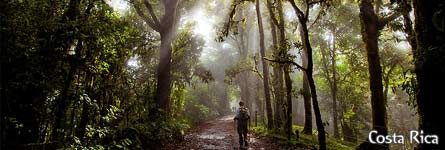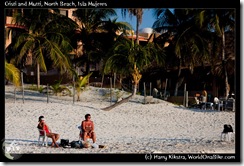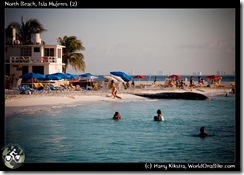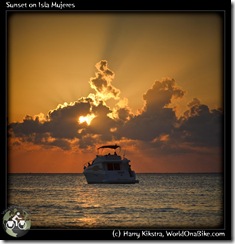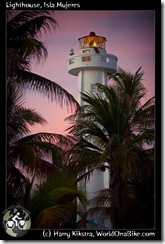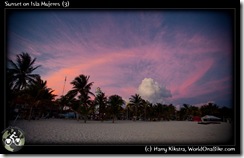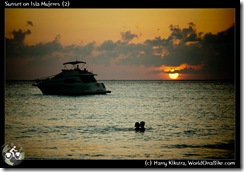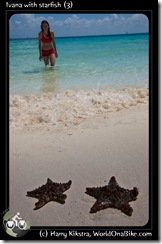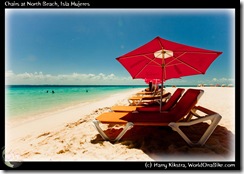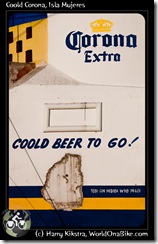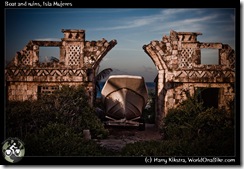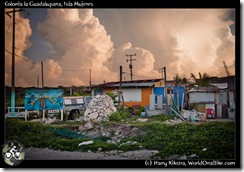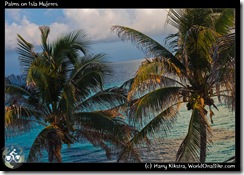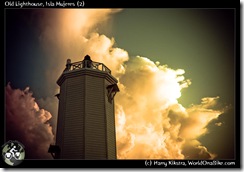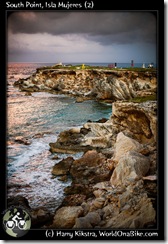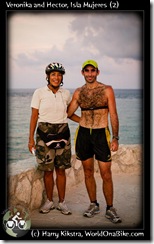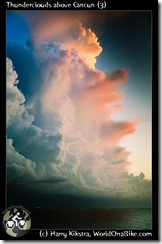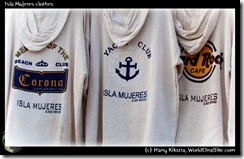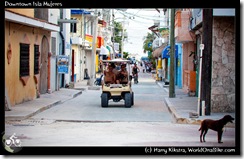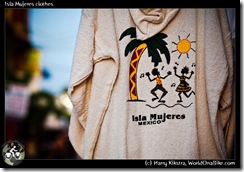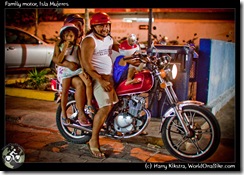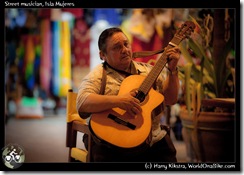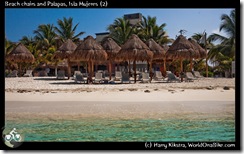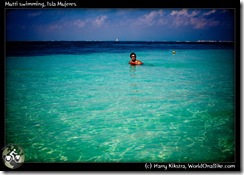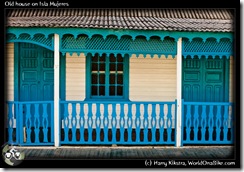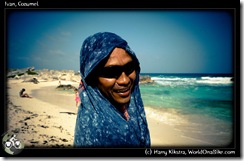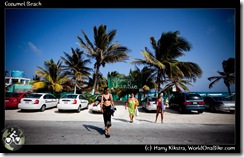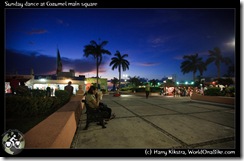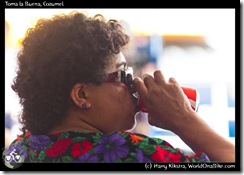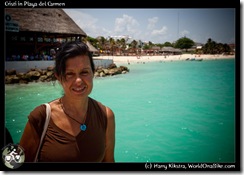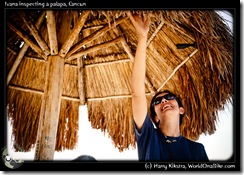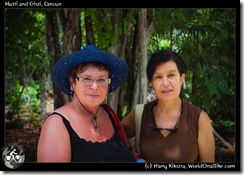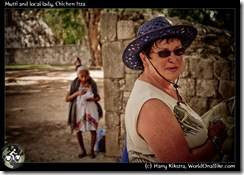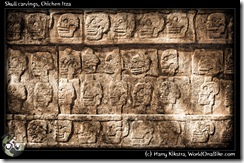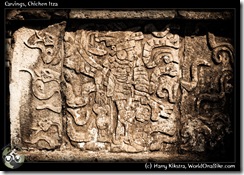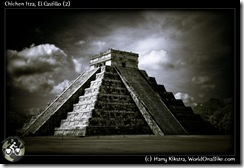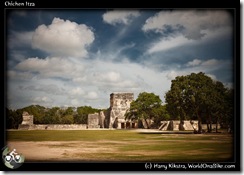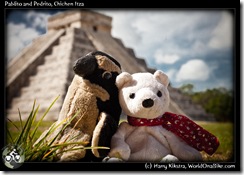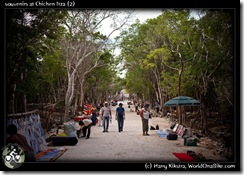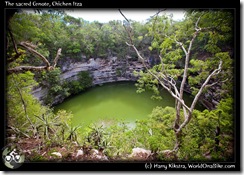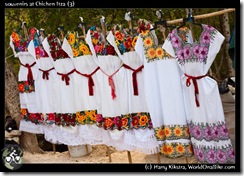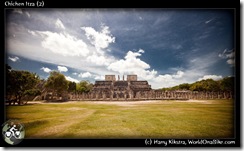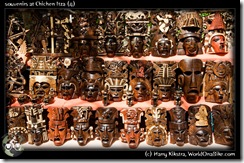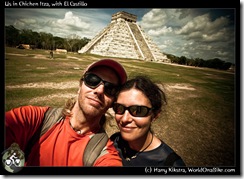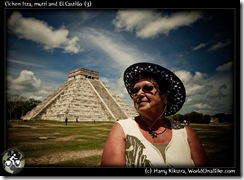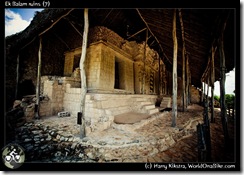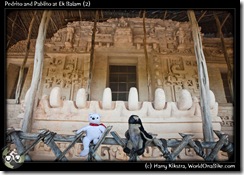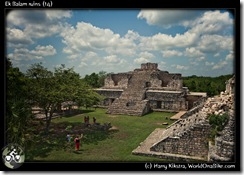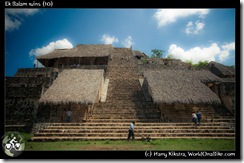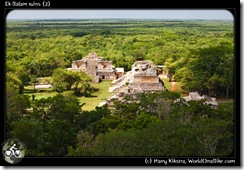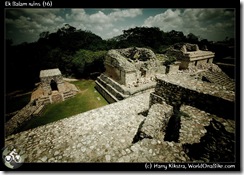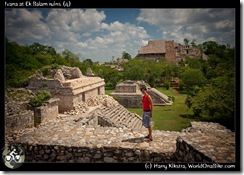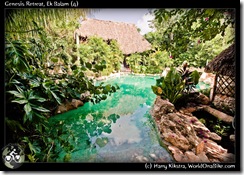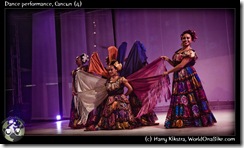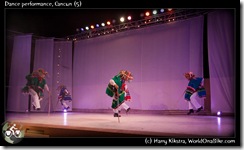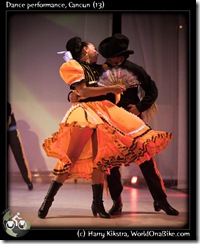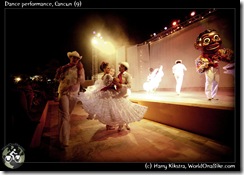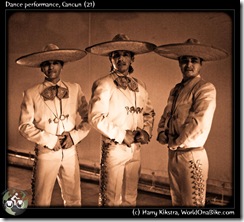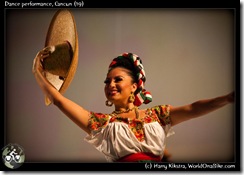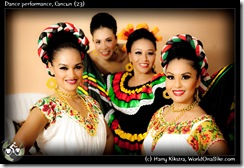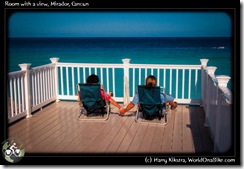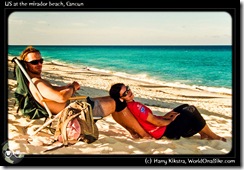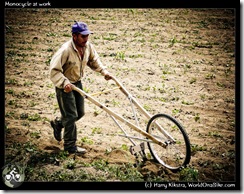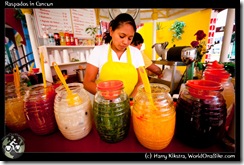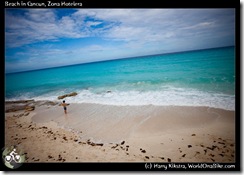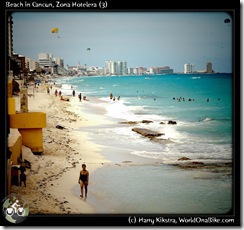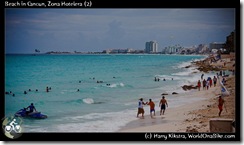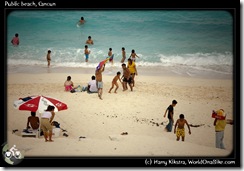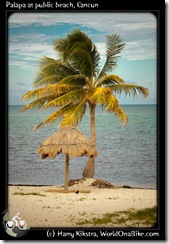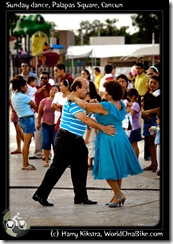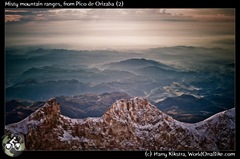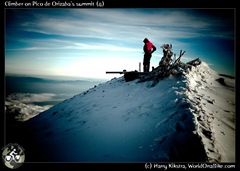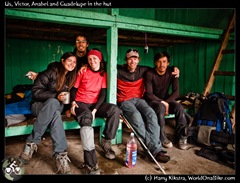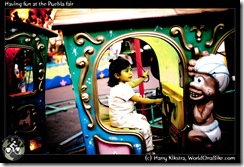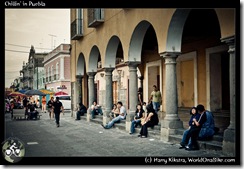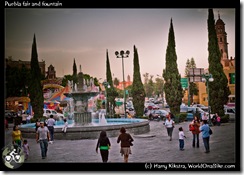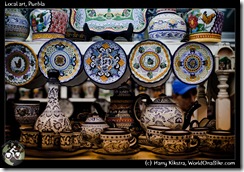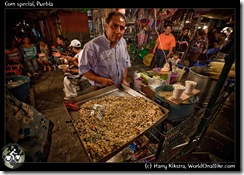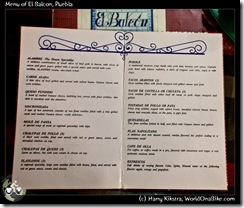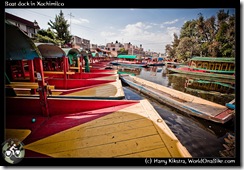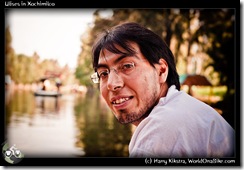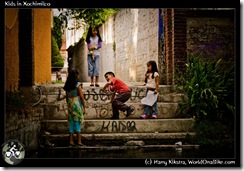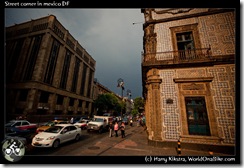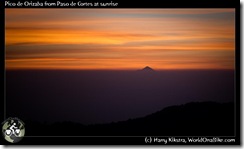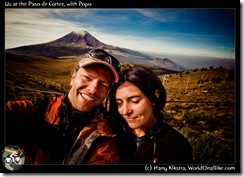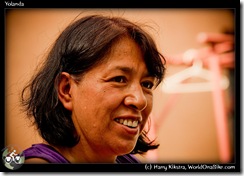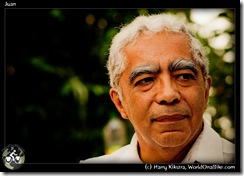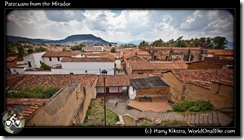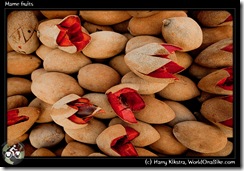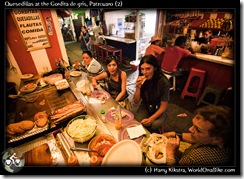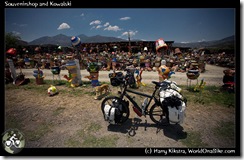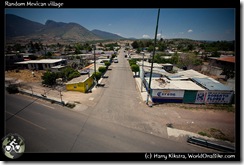Day 375-380, 21-26July 09: Interviews, fever, topes, laguna: down to Belize
October 17, 2009 by Harry,
Filed under Trip reports, North America, Mexico, Yucatan Peninsula
Happy B-day to me! My 2nd one on this trip and likely not the last… But there were a lot of things to do, no time to celebrate. I woke up with a very sore throat, but reckoned that it was he airco’s fault and did not think much of it.
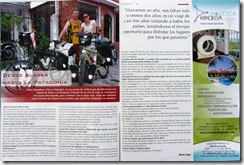 Ivana & I took our mums back to the airport in two separate transfers and then went over to Veronica & Hector to collect our stuff. We could have stayed with them again, but we had to get started to Belize, where my sister would arrive in 8 days time, so we said goodbye to our good friends that had helped us out so much.
Ivana & I took our mums back to the airport in two separate transfers and then went over to Veronica & Hector to collect our stuff. We could have stayed with them again, but we had to get started to Belize, where my sister would arrive in 8 days time, so we said goodbye to our good friends that had helped us out so much.
Hector took a nice photo of us outside their home and sent us an article in a magazine a while later, if you read Spanish you can click on the mage to the right to read it:
Hector also did a video interview, which can be seen here, in 2 parts on the video & interview page (in Spanish mostly).
The wind-gods were merciful for our first day on the bike in about a month, and we cruised the 70km Playa del Carmen in less than 4 hours. My throat did not feel so bad, but I was starting to get a huge headache, so I took one of the new migraine pills that Cristi had taken from Argentina. It did not get much better.
Our CouchSurfing host Ulises –who even spoke some Dutch thanks to his GF- had another guest coming and we went to pick her up together in the crazy downtown of PdC. Back home I crashed completely, with a big fever as an addition to the migraine, and could not appreciated the veggie ceviche that Ulises made as I would normally do. I stumbled to bed and felt hot and cold at the same time, not sleeping or resting much and awoke feeling I had plundered a cheap tequila bar the night before.
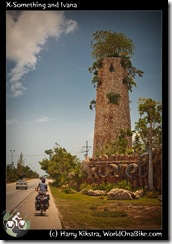 Ulises offered us to stay another day to recover, but as we did not have many spare days and it was only 45km to Tulum, we headed out. It was flat and boring again and we passed yet more places starting with an ‘X’ and containing ‘zip lines’ and other ‘eco-adventures’ like ruining the jungle with quads.
Ulises offered us to stay another day to recover, but as we did not have many spare days and it was only 45km to Tulum, we headed out. It was flat and boring again and we passed yet more places starting with an ‘X’ and containing ‘zip lines’ and other ‘eco-adventures’ like ruining the jungle with quads.
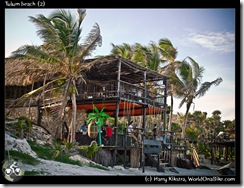 If the resorts do not start with an X, it is Not Maya and Not Fun Nor Adventurous. We were glad we were getting out of the reach of the Zona Hotelera, on the far horizon loomed the real world again…
If the resorts do not start with an X, it is Not Maya and Not Fun Nor Adventurous. We were glad we were getting out of the reach of the Zona Hotelera, on the far horizon loomed the real world again…
But first we planned to do a quick stop in Tulum, where yet another CouchSurfer was waiting.
I was far from a ‘Spanish’ mood. Usually I get tired of speaking, reading and hearing Spanish some time in the afternoon, but now I had already woken up exhausted and was happy that Lianne was Dutch, as my head was exploding and no other tongue worked.
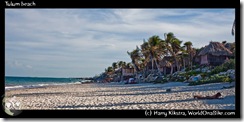 I do not remember much of the following 24 hours as I was sweating, hallucinating and trapped in some lost space-time continuum. Only at the end of the next day I had enough energy to cycle the 3km to the beach, where I had to lie down to recover and we stayed another night with Lianne.
I do not remember much of the following 24 hours as I was sweating, hallucinating and trapped in some lost space-time continuum. Only at the end of the next day I had enough energy to cycle the 3km to the beach, where I had to lie down to recover and we stayed another night with Lianne.
Mexican culture bonus: Topes
We have discussed a lot about Mexico in our recent updates covering the 4 months (!) we crossed the entire country from one side to another. The friendly people, the cities, the culture, the food, the nature.
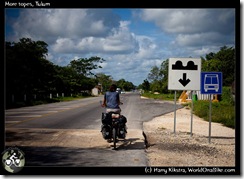 One very important thing I have not mentioned yet, while it is maybe one of the most important and widespread aspects of Mexican history when seeing through a cyclist’s glasses (which are usually a lot clearer than a driver’s glasses :))
One very important thing I have not mentioned yet, while it is maybe one of the most important and widespread aspects of Mexican history when seeing through a cyclist’s glasses (which are usually a lot clearer than a driver’s glasses :))
The Mexican love for speed-reducing things on the roads. As Mexicans are used to the fact that all major roads pass right through the middle of small towns, they are not used to slow down when they are driving and entering a pueblo.
Fines are seldom given and modern radar machinery seems confined to the Mexico DF limits. Threats like that do not work in the more short-term oriented parts of the world anyway, a practical and immediate solution was needed.
So they created bumps. Not those sissy bumps you see in the rest of the world, but real, car wrecking bumps in all shapes and sizes. Some of these, like the ones above are no problem for us as they are smooth. But the serious ones can really break your bike if you are not prepared and do not almost stop completely. I guess that is the point, though a bit moot for bikes.
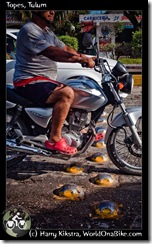 Some newer variations include 1-3 rows of metal domes, firmly attached to the ground. Sometimes local villagers (the ones that are not living in a 25 meter radius of the tope (Toh-puh)) manage to remove just enough so they can pass their vehicles at full speed, but most of the time they cover the entire road.
Some newer variations include 1-3 rows of metal domes, firmly attached to the ground. Sometimes local villagers (the ones that are not living in a 25 meter radius of the tope (Toh-puh)) manage to remove just enough so they can pass their vehicles at full speed, but most of the time they cover the entire road.
Whereas in the Netherlands, they would leave a gap for bicycles to pass safely, in Mexico this would invite drivers to use that gap. Actually even the shoulders of the road, so usually the topes are extended all the way across the dirt on the side. Some of the metal ones are quite dangerous, as the only ‘safe’ way to cross them on a bicycle is to approach them in a 45 degree angle and aim well. This is already a decent challenge, but of course in heavy traffic it takes on other dimensions – you also exit at the same angle if you managed not to fall over, so either while entering or exiting you end up in the middle of the lane.
If your angle is a few degrees off, your grip on the handle bars is not firm or the topes are too close together, there is a big chance you drop in front of some hungry diesel-stricken wheels. You can get off the bike and walk, but after the 4600th tope in a row, this gets old. Be warned for this authentic part of Mexican culture and you will still be amazed.
24th July 2009: Tulum to Felipe Carrillo Puerto, 90km
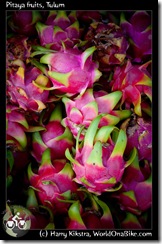 By now we had to hurry more than we wanted, but at least the roads through the stats of Quintana Roo are mostly flat, so it is easy to make some miles.
By now we had to hurry more than we wanted, but at least the roads through the stats of Quintana Roo are mostly flat, so it is easy to make some miles.
It was hot though and though I felt a bit better, I was cursing a lot when I got a flat in the middle of the hot day and it came off . I already hated my new back tire. The old Schwalbe Marathon tyre was actually still good after almost 11,000km/ 7000miles, but my mum had brought a new foldable version, that I had left with her in The Netherlands before departure. Normally I am a firm believer in the ‘if it ain’t broke, don’ fix it’ adagio, but as we had never replaced any tires and I still had another foldable tyre, I decided to change the back one on my bike.
I love the Marathons and the foldable is very useful as it fits neatly on the bottom the Ortlieb bags, but it is much better if they stay there. They are a royal pain in the saddle-sored behind to get on the wheel the first time and it does not get much easier after that. I do not like the fact that I had more flat tires in the first week of using them than the first 6 months of the other one, it seems that there are more differences between the 2 types beside the missing metal wire to make it foldable.
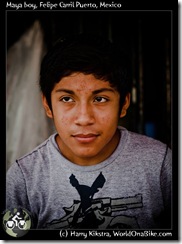 Just before reaching the town I had gotten another flat that I could not fix as one tube exploded when the foldable tire went outside the rim when almost fully inflated. The spare tube we were carrying somehow got a hole on the inside of the wheel and would not hold on to the patches.
Just before reaching the town I had gotten another flat that I could not fix as one tube exploded when the foldable tire went outside the rim when almost fully inflated. The spare tube we were carrying somehow got a hole on the inside of the wheel and would not hold on to the patches.
As one local motorist had already said that the Police would be able to help if needed, we decided that Ivana would cycle ahead and I would wait for her to return with the cops. Within 20 minutes a police pick-up came up to me and stopped on the side of the road. I walked up to them with my bike, but first had to identify myself.
‘What is your name?’ The officer asked surprisingly.
When I told him, he carefully compared my answer with the name that he had written in his notebook when Ivana told him about me. It took a minute or so, but after I also told him where I was from and that I really was the one that had sent Ivana for them to pick me up, he finally nodded and let me load Kowalski in the back. Apparently there were a lot of long-haired blond Dutchmen with a fully loaded bike with a flat tire just outside of the city limits and they had to take care not to pick up the wrong one…
Unlike the name suggests, FC Puerto does not have a harbour as it is inland. It is named after a revolutionary Zapatista from Mayan descent, who even had governed here for a short while. The city is still considered as a Maya ‘capital’ and the look and feel showed us that we had left the rich zone of Mexico.
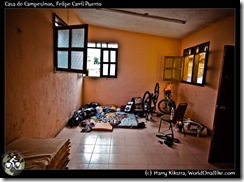 Finding a place to camp in the spacious city with lawns everywhere turned out to be a bureaucratic problem. The police decided that it was not safe to camp with them and took us and our bikes to the Firemen. After long discussions on the radio with lots of code numbers (they seemed to have a special code for stranded Argentinean/Dutch BikeTravellers) it was decided that, no, we could not sleep inside or outside the fire station, either.
Finding a place to camp in the spacious city with lawns everywhere turned out to be a bureaucratic problem. The police decided that it was not safe to camp with them and took us and our bikes to the Firemen. After long discussions on the radio with lots of code numbers (they seemed to have a special code for stranded Argentinean/Dutch BikeTravellers) it was decided that, no, we could not sleep inside or outside the fire station, either.
Meanwhile we had lost hours and it had become pitch dark, while I was feeling exhausted again. We finally ended up in the ‘Casa de Campesinos’, a small building with some mattresses, used by the local farmers coming from far away villages. I finally got to fix my bike while Ivana found some food and though we had the room to ourselves it was too hot to sleep properly…
25th July 2009: FC Puerto – Bacalar – 10km + a ride
After getting freshly squeezed juice and new tubes at the local bike shop, we headed out of the city. There were some very minor hills, and it was still relatively cool, but I totally crashed after 10km. Not in the sense of falling over or introducing Kowalski to a passing truck, but I simply could not cycle anymore. The flu had come back, I was overheating and could hardly sit down without passing out.
 After a while a pick-up truck passed that picked us, well, up and took us all the way to Bacalar, almost 100km away. It not only saved me from committing high-temperature velocipedal suicide, but also took a lot of pressure off, distance- and time-wise.
After a while a pick-up truck passed that picked us, well, up and took us all the way to Bacalar, almost 100km away. It not only saved me from committing high-temperature velocipedal suicide, but also took a lot of pressure off, distance- and time-wise.
Bacalar is one of the Pueblos Magicos, a list of 27 towns and cities in Mexico with special cultural or religious backgrounds, and that leave their visitors with a special feeling; in a positive way that is. We had only been to one other Magic Town, Patzcuaro, and that one was nice.
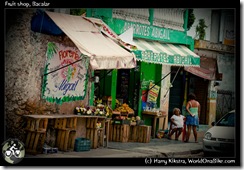 Bacalar was less spectacular, but maybe it would have been better without a flu.
Bacalar was less spectacular, but maybe it would have been better without a flu.
The centre is nice and they have a wonderful multicoloured lake where Ivana spent some hours floating, while I was resting in the cool breeze coming off it.
We stayed with Codrut, a friend of a CouchSurfing host in Bacalar. I spent most of the time resting and recovering and took a huge dose of anti flu and migraine pills. We decided to sleep outside on the porch, just on our mattresses as again it was too hot to be inside, and this time it wasn’t just me…
Here are some pix, so it might give you an idea of why so many gringos have bought all the land surrounding the lake:
Leaving Mexico for Belize
As Etta James would sing: At last.
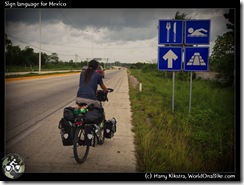 But not with a feeling of relief, but with a little pain in our hearts, homesickness to a new home. We had spent 4 months in this amazing place and though we literally crossed it from North West to South East and from Sea level to the highest peak, after 3000km/1900Mi of cycling and more than 1300km of rides we still felt we had only tasted a drop of the cultural and natural waterfall Mexico has to offer.
But not with a feeling of relief, but with a little pain in our hearts, homesickness to a new home. We had spent 4 months in this amazing place and though we literally crossed it from North West to South East and from Sea level to the highest peak, after 3000km/1900Mi of cycling and more than 1300km of rides we still felt we had only tasted a drop of the cultural and natural waterfall Mexico has to offer.
We were very happy to be able to tell our friends and family that we had zero real problems. I might have had the (swine?) flu, nearly overdosed on tasteless tortillas at times; we had some of the hottest nights in our lives and Ivana almost got run over by a truck.
We also met hundreds of kind people, saw historic sights, swam in sinkholes, felt like Indiana Jones, ate the best food, overdosed on fruits we had never even heard of before, camped in the desert, sailed between dolphins, visited magic towns, enjoyed the lazy beach life and climbed a glacier to the highest point between Canadian Mount Logan and Pico Cristobal Colon in the Columbian Andes.
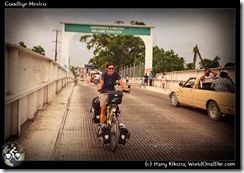 We hope to come back to Mexico some day, not to see a little bit of the rest this country has to offer, but also to meet our dozens of good new friends again.
We hope to come back to Mexico some day, not to see a little bit of the rest this country has to offer, but also to meet our dozens of good new friends again.
Thank you, Mexico.
Next stop: Belize!
Day 368-375, 15-21 Jul 09: Mums in Mexico pt.3: Isla Mujeres
October 1, 2009 by Harry,
Filed under Trip reports, North America, Mexico, Yucatan Peninsula
The Island of Women
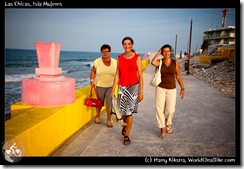 The ‘Isla Mujeres’, the Island of Women, could have been named after the wives of the pirates that frequented the seas and left their women on this safe island, or after the Mayan Goddess Ixchel, who has been worshipped here.
The ‘Isla Mujeres’, the Island of Women, could have been named after the wives of the pirates that frequented the seas and left their women on this safe island, or after the Mayan Goddess Ixchel, who has been worshipped here.
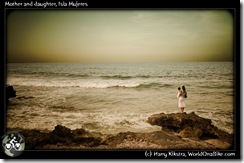 Nowadays, it can refer to the ladies living or the many visiting here, coming from nearby Cancun or from all over the world. so what is there to do on Isla Mujeres? Not much and that is exactly the point.
Nowadays, it can refer to the ladies living or the many visiting here, coming from nearby Cancun or from all over the world. so what is there to do on Isla Mujeres? Not much and that is exactly the point.
 Not the busy smelly traffic of downtown Cancun, not the mega-clubs, drunk teenagers and inflated prices of the Zona Hotelera. Not even the mega cruise-ships that frequent Isla Cozumel stop on the 8km (5mi) long island that is in places only 100m wide and never wider than 1km (0.6mi).
Not the busy smelly traffic of downtown Cancun, not the mega-clubs, drunk teenagers and inflated prices of the Zona Hotelera. Not even the mega cruise-ships that frequent Isla Cozumel stop on the 8km (5mi) long island that is in places only 100m wide and never wider than 1km (0.6mi).
 There are enough souvenir shops to keep you busy for several hours, you can rent a golf-cart to see the Southern part of the Island, but most people just come for the beach. Isla’s North beach (actually starting at the North-West) has white sands (crushed coral) with warm and clear green/blue waters.
There are enough souvenir shops to keep you busy for several hours, you can rent a golf-cart to see the Southern part of the Island, but most people just come for the beach. Isla’s North beach (actually starting at the North-West) has white sands (crushed coral) with warm and clear green/blue waters.
Nothing more and nothing less. As long as you are staying in Isla Mujeres Town, you can do everything on foot and if you are very active, you can see all the streets in one day, leaving the rest of your stay to relax!
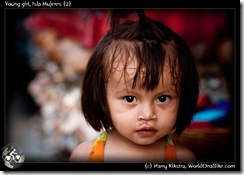 As we were still on a tight budget, but did not want to camp, I had come into contact with Gladys Galdamez from www.islabudgetrentals.com.
As we were still on a tight budget, but did not want to camp, I had come into contact with Gladys Galdamez from www.islabudgetrentals.com.
She had some more affordable options, but as they were still too much for us, I proposed to take some photos for her websites and house in exchange for housing and she accepted. So below are a lot of photos, some of which will also be found on her website 🙂
Life on the beach on Isla Mujeres
Pictures say more than words:
Running around the Isla with Hector & Veronica
As Isla is only a 20 minute boat ride away from Downtown Cancun, we had invited Hector & Veronica to come over to join us. They joined us on the beach for a while and then did their evening training on the island, one running while the other cycled and coached. I joined them on their other bicycle which was also a good excuse to see more of the Southern part of the island.
Here you go:
A taste of downtown Isla Mujeres
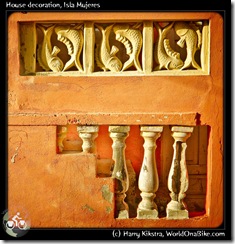 Isla Mujeres town is nothing more than a few streets, several restaurants and shops. One supermarket, a Central Plaza with a church and a basketball field complete the town.
Isla Mujeres town is nothing more than a few streets, several restaurants and shops. One supermarket, a Central Plaza with a church and a basketball field complete the town.
You can board for snorkelling tours, eat ice-cream, pancakes, hummus, pizza or tacos and tortas on the main square. Salesmen will try to sell traditional and less-traditional clothes and handicrafts, while tourists zoom past on the rented golf carts.
In the evening the streets are sparsely lit, the restaurants open and you might hear some nice live music from some of the older inhabitants of Isla Mujeres, a welcome change from the Mariachi-hell (pep-peppe-pep-pep!) of the rest of tourist-Mexico.
More life on a beach
 We spent most of our time on the beach. The mums were enjoying the sea and the two for one cocktail promotions (every hour on the beach is happy).
We spent most of our time on the beach. The mums were enjoying the sea and the two for one cocktail promotions (every hour on the beach is happy).
Though I like to swim, I get restless after an hour or so, unlike Ivana, who is perfectly happy floating on her newly-found air-mattress for several hours at a time.
Fortunately our room (my office) all the way on the other side of town was only 10 minutes walking away and there was always an excuse to take another photo.
Here are some:
Old Isla Mujeres & Miss Abuelita
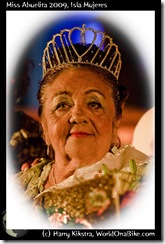 There is not much left of the old fisherman town, where people enjoyed their turtle soup. even though it is low key, tourism had changed everything. Still there are a few original houses to be found, preserved in bright paint.
There is not much left of the old fisherman town, where people enjoyed their turtle soup. even though it is low key, tourism had changed everything. Still there are a few original houses to be found, preserved in bright paint.
We were on the island for a festival in honour of one of the popular tourist attractions and endangered species that lives close to the island: the whale shark, a friendly whale-sized shark.
On the last evening the main attraction was presented: the election of Miss Abuelita, roughly translatable as Miss Granny 🙂
5 local ladies showed their local dress, evening gowns and their views of life in a heated battle. The jury had a hard time…
Birthday in Cancun and goodbye to the mums…
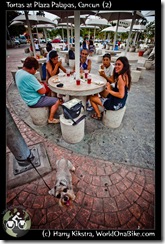 It was time to head back to the mainland, as both the mums would fly out to Argentina/Netherlands early the next morning.
It was time to head back to the mainland, as both the mums would fly out to Argentina/Netherlands early the next morning.
We invited Hector & Veronica for some tortas on the Palapas Square and started packing.
My mum had brought great new tiny summer sleeping bags from Carinthia. All our winter gear, including our warm Carinthia sleeping bags and down jackets, gloves, boots and several smaller pieces were going with Ivana’s mum to Argentina. We were planning to see them again somewhere around Peru.
 It was 20th of July, meaning that it would be my birthday at midnight. we had bought some cakes and some booze and had hired one of the friends of the Quetzal Hostel to mix up some mean mojitos and Pina Coladas to go along with it. It was a nice goodbye to our mums, who had flown halfway across the globe to see us.
It was 20th of July, meaning that it would be my birthday at midnight. we had bought some cakes and some booze and had hired one of the friends of the Quetzal Hostel to mix up some mean mojitos and Pina Coladas to go along with it. It was a nice goodbye to our mums, who had flown halfway across the globe to see us.
We had seen and done a lot in the past 3 weeks. It had not always been easy, we are so used to our own way of life and our mums are not 🙂
Also many times it was clear that the cultural differences between the Dutch and Argentinean way of life that had taken Ivana and me more than 3 years to -partly- overcome were very strong between our mums, sometimes leading to stress. But over all it was great to be able to share a part of our adventure and the wonderful world we live on with them and it was sad to say goodbye.
We actually had another vacation ahead of us as my sister and niece were going to land in Belize City in about 8 days to stay with us for 2 weeks. As it was over 500km from Cancun, it was time to pack the bikes again!
Day 361-367, 7-14 Jul 09: Mums in Mexico pt.2: Playa, more ruins & Isla Cozumel
September 28, 2009 by Harry,
Filed under Trip reports, North America, Mexico, Yucatan Peninsula
As mentioned in the previous post, we have parked our bikes for a few weeks as both our mums are visiting us on the Yucatan Peninsula. After the ruins of Chichen Itza & Ek Balam, it is now time for the beach!
Playa del Carmen, overcrowded and overrated
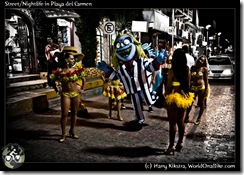 “Don’t go to Cancun, move to Playa de Carmen!”, was the advice of friends, websites and guidebooks. “More European, more relaxed, less commerce and more affordable than Cancun.”, were the reasons given.
“Don’t go to Cancun, move to Playa de Carmen!”, was the advice of friends, websites and guidebooks. “More European, more relaxed, less commerce and more affordable than Cancun.”, were the reasons given.
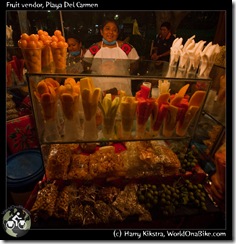 We arrived in our rental car and first could not park anywhere to find a hostel.
We arrived in our rental car and first could not park anywhere to find a hostel.
Finally we found a spot, only to find much more expensive hotels than in downtown Cancun. Once we found a decent room (3 beds, Ivana & I can share), we checked out the main street. It was filled to the top with souvenir shops and overpriced restaurants and hundreds of semi-relaxed tourists, many of them, yes, European. Large clubs and uber-cool lounge bars were promoted, while Guatemalan art was being sold for western art gallery prices.
 Finally we discovered some real food for almost downtown Cancun prices, sold on the streets close to the Central Plaza. Great juice and tortas, the Mexican sandwiches with a choice of meat and/or vegetables and different types of very spicy and tasty sauces.
Finally we discovered some real food for almost downtown Cancun prices, sold on the streets close to the Central Plaza. Great juice and tortas, the Mexican sandwiches with a choice of meat and/or vegetables and different types of very spicy and tasty sauces.
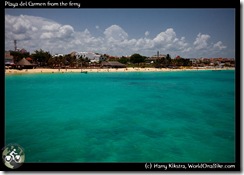 Just a bit ahead were the local fruit ladies selling nice big bags of mixed cut fruits for less than half of the price of a glass of water in a restaurant of the main street.
Just a bit ahead were the local fruit ladies selling nice big bags of mixed cut fruits for less than half of the price of a glass of water in a restaurant of the main street.
The beach is very nice at Playa and the water is green-blue as in the brochures, but it’s like that all along the Costa Maya.
The girls were happy with the sea and sand, but I rather wanted to use the last day we had a car to see one more ancient Maya City and took off alone.
More ruins, Coba solo
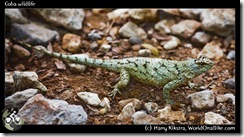 Coba has the same charm that Ek Balam has and that Chichen Itza is lacking: the ‘Indiana Jones’ sense that you are discovering the ancient hidden cities yourself while strolling through the lush Jungle.
Coba has the same charm that Ek Balam has and that Chichen Itza is lacking: the ‘Indiana Jones’ sense that you are discovering the ancient hidden cities yourself while strolling through the lush Jungle.
The structures of Coba are not as neatly organised and lined up as in Chichen Itza. From the first group, which contains the large ‘Templo de las Iglesias’, the temple of the Churches, it is more than a kilometre walk through the jungle if you want to see some of the other big ones.
 Several dozen sacbe’s, ancient Mayan road crossed the surrounding jungle to get to Coba, an important hub in times gone by. Only a few percent of the estimated 6500 (!) structures of Coba have been excavated, and many of these not even fully and the jungle has remained intact, which is good news for the many different animals living there.
Several dozen sacbe’s, ancient Mayan road crossed the surrounding jungle to get to Coba, an important hub in times gone by. Only a few percent of the estimated 6500 (!) structures of Coba have been excavated, and many of these not even fully and the jungle has remained intact, which is good news for the many different animals living there.
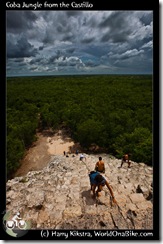 It is hot in Coba, even in the shade of the trees and for those who do not want to walk the sacbe’s there are many eco-taxis handy: bicycles & rickshaws!
It is hot in Coba, even in the shade of the trees and for those who do not want to walk the sacbe’s there are many eco-taxis handy: bicycles & rickshaws!
The largest Maya structure (of the entire Peninsula) is called Nohoch Mul, better known as the Great Pyramid and its eroded steps leading to the 42m (140ft) high top can fortunately still be climbed. 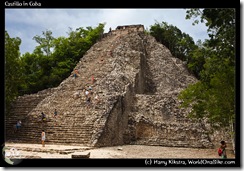 A thick rope is attached to help the brave people down that made it up and realized that it was quite high and the steps narrow and down-sloping 🙂
A thick rope is attached to help the brave people down that made it up and realized that it was quite high and the steps narrow and down-sloping 🙂
There will be several persons on the Pyramid, but the views are great: jungle as far as the eye can see. The sweet views are spiced with the knowledge of the thousands of hidden treasures still to be found.
Tulum: busy ruins and empty beach
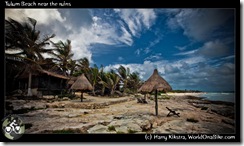 I was just too late to make a quick visit to the most popular Maya ruins: Tulum. As it is close to Cancun and Playa de Carmen, and the site is open and compact, bus loads of tourists come here every day.
I was just too late to make a quick visit to the most popular Maya ruins: Tulum. As it is close to Cancun and Playa de Carmen, and the site is open and compact, bus loads of tourists come here every day.
 I saw a huge line of them coming out of the exit and caught a glimpse of the famous Castillo, with its postcard location on the edge of the sea. I was not allowed in, but used my time to view some nearby rough beaches, totally deserted.
I saw a huge line of them coming out of the exit and caught a glimpse of the famous Castillo, with its postcard location on the edge of the sea. I was not allowed in, but used my time to view some nearby rough beaches, totally deserted.
It was time to return to Playa de Carmen and head over to our next destination: an island!
Isla Cozumel, CouchSurfing and anniversary on the divers and cruise-ship paradise
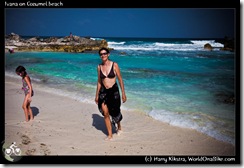 One part of our way of travelling that we wanted to share with our mums was the use of the CouchSurfing and WarmShowers network, where travellers host other travellers. We managed to find a great host on the Island of Cozumel, that agreed to host all 4 of us.
One part of our way of travelling that we wanted to share with our mums was the use of the CouchSurfing and WarmShowers network, where travellers host other travellers. We managed to find a great host on the Island of Cozumel, that agreed to host all 4 of us.
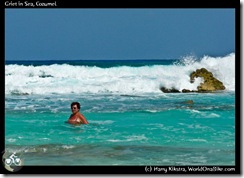 Ivan not only provided us with a great place to sleep, but also gave us a quick tour of the rough east side of the diver’s paradise, with some great swimming beaches and blowholes. The next day he took Ivana, Cristi and myself for a nice little snorkel tour, while my mum relaxed in a hammock near a pool. Life should not get much harder than this 🙂
Ivan not only provided us with a great place to sleep, but also gave us a quick tour of the rough east side of the diver’s paradise, with some great swimming beaches and blowholes. The next day he took Ivana, Cristi and myself for a nice little snorkel tour, while my mum relaxed in a hammock near a pool. Life should not get much harder than this 🙂
It was wonderful to have such a perfect example of a great CouchSurfing host to demonstrate to our mums a taste of the hospitality we have encountered all over Mexico, USA and Canada, made possible by the technology and the mentality of our generation, but which has spread far beyond that.
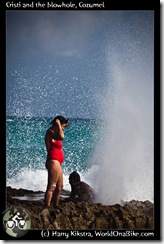
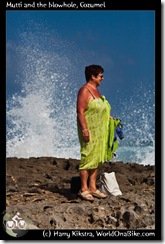
 –
–
Cozumel is a popular stop for huge cruise-ships and we saw many pass during the few days we were there. But to see further than the shopping tours along the silver-shops and the basic restaurants, you need to spend some days there.
For example it gives you the chance to see the local Sunday dance on the main square, where the local couples dress up and play to the music of a live band, while the sun sets behind a blue and purple sky.
Next and final part of the Mother-ship series coming up: An Island of Women!
Stay tuned, it will be up and running soon as long as the Internet gods are willing 🙂
Day 354-360, 30Jun-6Jul 09: Mums in Mexico pt.1: Ruins & Cenotes!
September 26, 2009 by Harry,
Filed under Trip reports, North America, Mexico, Yucatan Peninsula
Photos: relaxing in Cancun
We started our holiday with a few days in a Hostel and some visits to the beach as well as the nice local park. The park is not visited much, but is basically a part of original jungle in the middle of the city. It has some great trails, a turtle pond, many lizards walking around and we even saw a snake.
Off to the Maya Ruins: Chichen Itza!
Of course you cannot visit Central America without visiting at least some of the ancient Maya cities. Cancun is quite close to Chichen Itza, maybe the most famous city of them all, especially after a huge marketing campaign managed to get it entered as one of the new 7 wonders of the world.
We had rented a cheap car for a week, so we could tour around for a while, leaving the beaches for later. Our mums experienced a hint of our way of life when we told them that they could only take 1/3 of their luggage –as more did not fit in the tiny car- and that they would see the rest only in a week 🙂
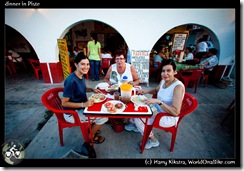 There is a wonderful new highway from Cancun to Chichen Itza, but we only found out why it was so deserted (we saw 2 cars in 200km), when we needed to pay over USD 20 in toll fees, close to the exit. Now we understand why Francisco and the other truckers all choose the ‘Libre’ road instead.
There is a wonderful new highway from Cancun to Chichen Itza, but we only found out why it was so deserted (we saw 2 cars in 200km), when we needed to pay over USD 20 in toll fees, close to the exit. Now we understand why Francisco and the other truckers all choose the ‘Libre’ road instead.
The mums got another taste of our trip when we booked them in a small but cheap guesthouse, with 3 beds in a dusty and very hot room in Piste, the town next to the old Maya City. We had arrived in the afternoon, so we had time to have some dinner and go to Chichen Itza for the evening show. 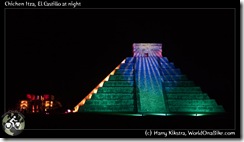 Most people do not see this as they come on day trips from Cancun & Merida, but every evening the main structures are illuminated at sunset, while a set of voices tell about the history and legends of Chichen Itza.
Most people do not see this as they come on day trips from Cancun & Merida, but every evening the main structures are illuminated at sunset, while a set of voices tell about the history and legends of Chichen Itza.
The Spanish whispering was a bit too much for me, but it was nice to sit in the fresh breeze while the most famous main structure, the temple of Kukulkan, better known as ‘El Castillo’ -the castle- turned form green to purple.
Here is a photo impression (click to enlarge, more photos in the photo section here).
Souvenirs & Cenotes
Of course the place is stuffed with souvenirs and other semi-local handicrafts. The sacbe number 1, the ancient Mayan road, leading to the ‘cenote’ was lined with vendors. The Yucatan peninsula is lined with Cenotes, which can be anything from a large pond to a huge underground cave filled with water. The soft limestone base of the peninsula combined with tropical rainfall had created these holes and many of them were either sacred or at least an important water source.
The cenote at Chichen Itza was found to contain several artefacts and bones, it was clearly used as a sacrificial place. Some more pix 🙂 :
Swimming in the Cenotes
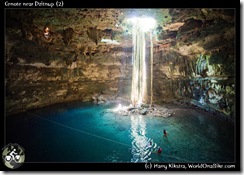
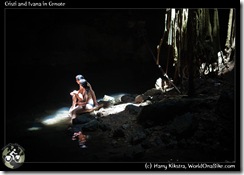
 Not all cenotes are closed to the public. In fact there is a large tourism sector focused on either swimming in them or even exploring them while diving, as many are connected by underground rivers. We stuck to swimming in a couple, with the first one being close to the town of Dzitnup.
Not all cenotes are closed to the public. In fact there is a large tourism sector focused on either swimming in them or even exploring them while diving, as many are connected by underground rivers. We stuck to swimming in a couple, with the first one being close to the town of Dzitnup.
The cenote is inside a huge a cave, but it had a hole on top where sunlight shines through. next to the hole grows a tree and it roots come all the way down to the water, a magic place for sure..
Jungle ruins: Ek Balam
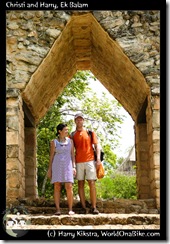 The ruins of Chichen Itza are the most famous, but its popularity has caused some downsides. You can no longer climb on El Castillo as a tourist had fallen to her death a few years ago and the sheer number of visitors can cause irreplaceable dame to the structure.
The ruins of Chichen Itza are the most famous, but its popularity has caused some downsides. You can no longer climb on El Castillo as a tourist had fallen to her death a few years ago and the sheer number of visitors can cause irreplaceable dame to the structure.
Also most of the other structures are off-limits now, meaning you can only see them from a (short) distance.
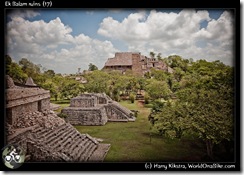 Therefore it was nice to visit a much ‘newer’ site, Ek Balam. Largely unknown for mass tourism, but with some impressive structures, of which the 2nd and 3rd largest are still unexcavated and buried by the force of nature.
Therefore it was nice to visit a much ‘newer’ site, Ek Balam. Largely unknown for mass tourism, but with some impressive structures, of which the 2nd and 3rd largest are still unexcavated and buried by the force of nature.
The highest structure, known as the Acropolis, can be climbed on its narrow and sloping steps, offering great views over the site and the surrounding jungle.
Somehow, it felt more ‘real’ being here compared to Chichen Itza. An impression:
X’Canche & Genesis: Swimming and relaxing in Ek Balam

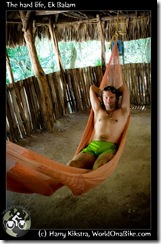 Ek Balam had one bonus: it has an open Cenote (meaning open to the public, you still have to pay an entrance fee) a 15 minute walk from the ruins.
Ek Balam had one bonus: it has an open Cenote (meaning open to the public, you still have to pay an entrance fee) a 15 minute walk from the ruins.
This one was open, but also had many roots growing into it, as well as many fishes and plant and we enjoyed the cooling water as well as the collection of free hammocks nearby.
We had spent a few days in the wonderful Genesis Resort in the nearby village of Ek Balam, run by Lee Christie. A nice oasis in the dry surroundings, it had a great swimming pool and evens some bike for rent. In exchange for a discount on the price of the room, we cleaned and fixed the bikes, so that they were safe again 🙂
On the road again
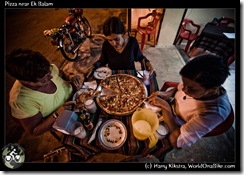 After a huge pizza in a nearby village, and some clothes testing for Pablito and Pedrito, it was time to hit the road again. Not to the ruins and beaches of Coba & Tulum as planned, but back to Cancun, this time on the libre road. Ivana had to undergo a second part of a dental treatment, as part of her tooth had broken off the day our mums arrived.
After a huge pizza in a nearby village, and some clothes testing for Pablito and Pedrito, it was time to hit the road again. Not to the ruins and beaches of Coba & Tulum as planned, but back to Cancun, this time on the libre road. Ivana had to undergo a second part of a dental treatment, as part of her tooth had broken off the day our mums arrived.
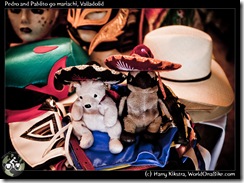 It was fixed ok, but the next problem was that both Cristi as well as myself developed a rash on our legs and arms, there must have been something in the Cenote water, though Ivana had no problems.
It was fixed ok, but the next problem was that both Cristi as well as myself developed a rash on our legs and arms, there must have been something in the Cenote water, though Ivana had no problems.
It was time to hit the other famous parts of the Yucatan Peninsula: the beaches!
Day 346-353, 22-29 June 09: Chillin with Hector & Veronika in Cancun
September 24, 2009 by Harry,
Filed under Trip reports, North America, Mexico, Yucatan Peninsula
Meeting old friends in Cancun
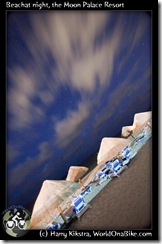 A few years ago, I was on my way to run the Amsterdam Dam-to-Dam run. Ivana was joining me to the start when we saw two biketravellers pass by; loaded bikes, with a Mexican flag on the back.
A few years ago, I was on my way to run the Amsterdam Dam-to-Dam run. Ivana was joining me to the start when we saw two biketravellers pass by; loaded bikes, with a Mexican flag on the back.
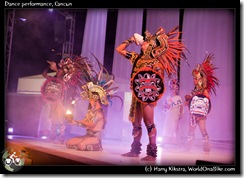 While I went to run, Ivana caught up with the cyclists and asked if they needed a place to sleep.
While I went to run, Ivana caught up with the cyclists and asked if they needed a place to sleep.
It turned out that they did and as there were problems with their ticket, the couple stayed 2 nights at our place, our first experience as a WarmShowers host. After we found out that hector & Veronika were living in Cancun, we told them: cool, you might be able to return the favour in about 2 years 🙂
Fast forward to June 2009…
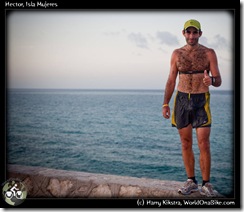 It was great to see Hector & Veronika again. They took us to their small apartment and the following week we spent most of the time together. They helped us out buying some new things, finding a hostel for our mums who would arrive at the end of the week and showed us around in Cancun.
It was great to see Hector & Veronika again. They took us to their small apartment and the following week we spent most of the time together. They helped us out buying some new things, finding a hostel for our mums who would arrive at the end of the week and showed us around in Cancun.
 Hector repairs Computers and runs professionally, generating a large part of their income by winning prizes.
Hector repairs Computers and runs professionally, generating a large part of their income by winning prizes.
Veronika is an experienced massage therapist and a professional dancer in the famous Maria Felix dance company, performing several times per week in exclusive resorts. We managed to get smuggled in one night and saw their amazing performance, showing the dances and clothing of several regions of Mexico with an incredible power. Here are some photos from that show (more photos in the photo section here).
Relaxing at the beach
Though we had ridden the last part in a truck, we still felt we deserved a few relaxing days after 10,611km (6600mi) of cycling from Alaska. We had seen the beaches with Francisco and Daniel, but Hector took us for some quality time around and in the sea, here are some great photos he took of us:
The mother ship has landed…
It had had taken some planning and headaches, but we had managed.  Both our mums thought that 2-3 years away from home was too long, so we had decided to invite them to meet us somewhere on our trip and show them a bit of our way of life.
Both our mums thought that 2-3 years away from home was too long, so we had decided to invite them to meet us somewhere on our trip and show them a bit of our way of life.
Cancun seemed perfect as it was about as far from Argentina as from the Netherlands and it had a large international airport.
We had booked the flights (goodbye travel budget :)) just in the week before the announcement of the outbreak of the ‘Swineflu’, but by now most of the hype was gone and all seemed safe.
Both mums had no extra-continental travel experience but both had to change planes in strange countries (USA & Chile/Panama), which was far scarier than any flu. Lo and behold, within a few hours of each other both had arrived. Completely exhausted, but happy to see us. We had parked our bikes at Hector’s house, time for some touring!
Day 342-346, 18-22 June 09: Elections, downhill and to Cancun: World-in-a-Truck
September 22, 2009 by Harry,
Filed under Trip reports, North America, Mexico, Central Mexico, Yucatan Peninsula
18 June 2009: Election tricks, graffiti & handwork
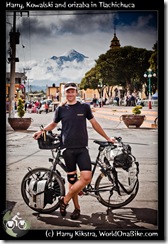 We did a quick tour around the central Plaza in Tlachichuca for some Wi-Fi search and some posing for pictures. I noticed a huge truck unloading hundreds of boxes with a growing crowd gathering around.
We did a quick tour around the central Plaza in Tlachichuca for some Wi-Fi search and some posing for pictures. I noticed a huge truck unloading hundreds of boxes with a growing crowd gathering around.
The boxes contained live chickens and were handed out to the villagers. The magazine salesman that had just treated us to some tacos viewed the scene with a look of disgust.
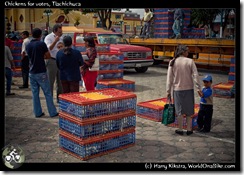 “It is the PRI, buying votes. People sell their right to vote for the short term benefit of a chicken. Afterwards they will endure another 4 years of suppression by the rich folks that run the party.”
“It is the PRI, buying votes. People sell their right to vote for the short term benefit of a chicken. Afterwards they will endure another 4 years of suppression by the rich folks that run the party.”
Welcome to the Mexican elections, where votes are bought with live chickens!
 We had already seen signs of the election everywhere. Mexicans in general seem to have a morbid fear of white surfaces, as every wall, of every house, compound or fence always contains graffiti, without exception.
We had already seen signs of the election everywhere. Mexicans in general seem to have a morbid fear of white surfaces, as every wall, of every house, compound or fence always contains graffiti, without exception.
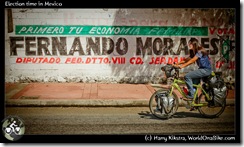 Some times it is just marketing, with the name of the shop or the biggest brands they sell, many times it is just defacing stupid graffiti.
Some times it is just marketing, with the name of the shop or the biggest brands they sell, many times it is just defacing stupid graffiti.
But in the last months before the general elections in July, the majority of all walls have been taken over by the election marketeers promoting their candidates with populist slogans:
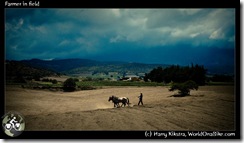 “Your Household Economy comes first!”, “Only we want more jobs for you!” and the classic “Cheaper gasoline for everybody!”.
“Your Household Economy comes first!”, “Only we want more jobs for you!” and the classic “Cheaper gasoline for everybody!”.
We cycled through fields of corn, where old famers were working without any motorized means. All waved when we passed them, on our way to one of the biggest downhills of our entire journey…
After rounding the Ciudad Serdan and climbing some minor hills, we reached the main highway again. The tollbooth attendants did not even see us and so we found ourselves back on the ‘Quota’!
From the highlands to sea level: 400m up, 2500m down in 133km!
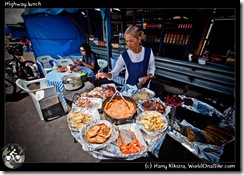 After a quick roadside lunch we started our descent. It was not as relaxed as imagined beforehand as the road was busy and the shoulder filled with rocks and debris of tires and other car parts. Worst of all, we headed into a chilly thick fog, limiting the view in front and behind us to about 40 meters, so we had to brake all the way, wearing our reflective jackets for safety and our rain jackets for warmth.
After a quick roadside lunch we started our descent. It was not as relaxed as imagined beforehand as the road was busy and the shoulder filled with rocks and debris of tires and other car parts. Worst of all, we headed into a chilly thick fog, limiting the view in front and behind us to about 40 meters, so we had to brake all the way, wearing our reflective jackets for safety and our rain jackets for warmth.
The drop-off is so steep that when the highway had to be expanded due to increasing traffic, they basically had to built a new highway as the existing one could not be broadened in most places. The only times when there was some extra room, long emergency gravel pits were built, to save truckers going down with faulty brakes.Fortunately when going down we followed the original one, which went just straight down instead of up, down, around and over like the new variation.
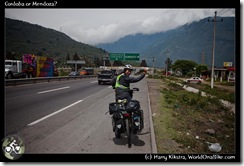 Ivana wanted a picture with the turn-off to Cordoba and Mendoza, both two cities near her province in Argentina and soon after we got the first of several flat tires.
Ivana wanted a picture with the turn-off to Cordoba and Mendoza, both two cities near her province in Argentina and soon after we got the first of several flat tires.
During the downhill Ivana had not managed to avoid al exploded tires and her tires were punctured with several thin but strong parts of steel wire that strengthen the truck tires. Fixing tires on the side of a busy highway is not my favourite thing to do, but there was no other option.
We had lost enough altitude to be in the warmer air of the tropics again. We also got treated to our first heavy tropical rain shower. Actually, when thinking about it, it was the first rain since Central California, USA!
The slope eased, but still we were going down. The view of mighty Pico de Orizaba must be wonderful from this side, but all we could see behind us was a big pile of tropical clouds. We ended our day after 133km, about 4 flat tires and 2500m of downhills in a wet garden next to the highway, with mangos falling from the trees and chickens scaring Ivana.
19/20th June: the long ride to Cancun: World On a Truck
The downhill had ended and we rollercoastered to the junction of the toll roads. Ahead was Veracruz, we turned right towards the east, as we had to get to Cancun with a few days, so we needed some good place for our hitchhiking.
It took about 50km, but we found a gas station where we could ask refuelling pickups for a ride. Then things went fast.
The first ride took us about 200km down the road. We cycled a few minutes to a toll booth and got another ride quickly, which took us 60km. When we left them we noticed a big truck we had seen before. The friendly driver, who had waived at us when he had passed us before, asked us where we were going.
We replied that we were trying to get rides to get North-East.
“I am going to Cancun, want to join?”.
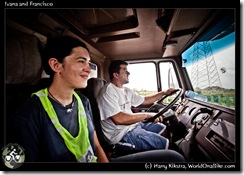 Cancun! It still was about 1100km/700miles away. We introduced ourselves properly to Francisco, a gentle man who runs a moving company from the border with Texas. He has a fleet of about 20 trucks and regularly drives himself as well. His truck was already half empty, with 2 loads left to drop off: one in Merida and one in Cancun!
Cancun! It still was about 1100km/700miles away. We introduced ourselves properly to Francisco, a gentle man who runs a moving company from the border with Texas. He has a fleet of about 20 trucks and regularly drives himself as well. His truck was already half empty, with 2 loads left to drop off: one in Merida and one in Cancun!
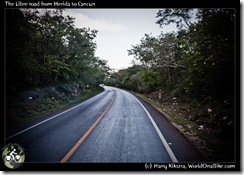 We put our bikes in the back and joined him in the cabin for a long ride to the Yucatan peninsula. After a roadside dinner he parked the truck at a truck-stop and while he slept in the cabin, we slept in the back of the truck, inside the tent against the mosquitoes, but the sweaty heat kept us awake.
We put our bikes in the back and joined him in the cabin for a long ride to the Yucatan peninsula. After a roadside dinner he parked the truck at a truck-stop and while he slept in the cabin, we slept in the back of the truck, inside the tent against the mosquitoes, but the sweaty heat kept us awake.
As the toll roads are too expensive, Francisco took the ‘libres’, meaning extra kilometres and much extra traffic. We slowly passed through the states of Tabasco & Campeche and ended up in Merida. The city is known for it beautiful centre, but we had to unload the possessions of a family that had worked in the US for a while in a less scenic part of town, where the roads were littered with trash.
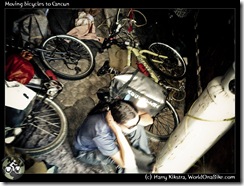 Francisco hired a few guys at the entrance of the city to help us unload in the heat. After getting paid, they bought 6 bottles of beer, which were emptied and thrown out of the window before we could take them back to where we had picked them up.
Francisco hired a few guys at the entrance of the city to help us unload in the heat. After getting paid, they bought 6 bottles of beer, which were emptied and thrown out of the window before we could take them back to where we had picked them up.
It was time to cross the Yucatan state. There is a huge and expensive new quota, so we took the dark and windy libre instead. The road passes through every little town and we had to stop hundreds of times to carefully cross the many ‘topes’, speed bumps.
We arrived late at night but 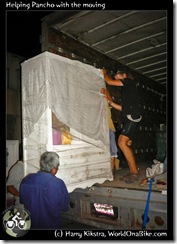 still had one load to deliver before we could find a place to sleep.
still had one load to deliver before we could find a place to sleep.
After we finished 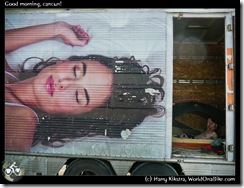 Francisco parked the car in the centre and went to sleep in a friends house, while we erected the tent again, inside the truck.
Francisco parked the car in the centre and went to sleep in a friends house, while we erected the tent again, inside the truck.
We had been rushing the past weeks, but now we had made it to Cancun a week earlier than planned. It took a huge load off our shoulders as we now had some time to check out the city and prepare the visit of our mums.
Cancun
Francisco came back to his truck in the morning, and his friend Daniel invited us to come over and stay in his house. We had friends in Cancun, but as we had arrived so quickly, we had not been able to contact them and gladly accepted Daniel’s offer.
He not only put us up for the night, but also gave us some tours, which helped a lot to understand the city. We visited the touristic places as Francisco had to buy some jewellery for his wife and drank some “raspados”, shaved ice with sweet fruit flavours.
Cancun proper: the beach!
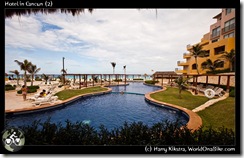 The city were we were is actually not the Cancun that is so famous. The downtown area is where the people live and go for their Sunday dance, the tourists go to a 25km/16mi long peninsula, totally covered with big expensive hotels, clubs and restaurants.
The city were we were is actually not the Cancun that is so famous. The downtown area is where the people live and go for their Sunday dance, the tourists go to a 25km/16mi long peninsula, totally covered with big expensive hotels, clubs and restaurants.
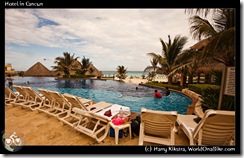 Though all beaches are public and thus open to everybody by law, in practice it is very hard to get to them, as the hotel properties are private and they are all built next to each other.
Though all beaches are public and thus open to everybody by law, in practice it is very hard to get to them, as the hotel properties are private and they are all built next to each other.
Daniel had worked in the hotel business before and took us to see the “Zona Hotelera”. We visited a few of the smaller public beaches, with did have easy access, but we also checked out a large hotel. It was something we will never be able to afford, but it was fun to pretend 🙂
Kowalski! Status report!
All is well. We will park our bikes soon as our mums will arrive and we will be semi-proper tourists for a while. But still there are plenty of things to show, so stay tuned…
Day 338-341, 14-18 June 09: Pico de Orizaba, summit of Mexico
September 20, 2009 by Harry,
Filed under Trip reports, North America, Mexico, Central Mexico
14th June, From Puebla to Tlachichuca: dust devils and up the slopes of the volcano. 52km, about 500m up
After our goodbyes to Hiram’s family, we found our way through the busy streets of Puebla, heading North East to to the exit of the city, the main highway towards Veracruz on the Gulf coast. Our mums would arrive in Cancun, more than 1600km away via busy highways, in 2 weeks and we had to be there several days before to arrange accommodation, trips etc. We needed to make at least 150km per day, either cycling or taking a ride. Still there was one thing left to do, before heading for the Mexican Riviera Maya…
The toll road was busy and noisy as was to be expected and during the day we took 2 rides until we arrived at a slightly less busy road heading North (no!!!). After turning East again, we headed in the direction of a huge pile of clouds. The road looked flat, but in reality it was gently but constantly sloping up. It felt like we were cycling with our brakes stuck, or with a flat tire.
 Ivana was just 100m behind when I stopped in a small town to wait for her, but she got right in a path of a dust devil, sweeping through the streets and depositing Madre Tierra all over her. There were dust devils everywhere on the fields and we had to sprint a few times to avoid one.
Ivana was just 100m behind when I stopped in a small town to wait for her, but she got right in a path of a dust devil, sweeping through the streets and depositing Madre Tierra all over her. There were dust devils everywhere on the fields and we had to sprint a few times to avoid one.
At about 2400m altitude we reached our goal for the day: Tlachichuca, a slightly depressing town, with just one real benefit for us: it is the starting pint for ascents of the highest mountain of Mexico: Citlaltepetl, better known as Pico de Orizaba! Depending on the source, it is between 5611 & 5700m (approx 18,700ft) high.
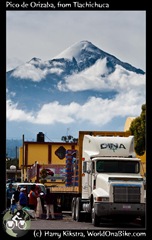 This makes it not only the highest point of Mexico, but also after Denali (Alaska) and Mount Logan (Canada), the 3rd highest peak in North America. It is not a technical climb, merely a long hike, but still crampons and ice-axe are needed as even though it is shrinking rapidly, there is still a glacier on the upper part.
This makes it not only the highest point of Mexico, but also after Denali (Alaska) and Mount Logan (Canada), the 3rd highest peak in North America. It is not a technical climb, merely a long hike, but still crampons and ice-axe are needed as even though it is shrinking rapidly, there is still a glacier on the upper part.
As I have many US clients for my organised 7summits.com expeditions to Kilimanjaro, Aconcagua & Elbrus, the summits of Africa, South America and Europe, it would be nice to offer a climb of Pico de Orizaba as well. It is very close to the US, affordable and a good way to test how you are doing on ice, and at a similar altitude and you can use it as pre-acclimatisation, making the other climbs a lot easier.
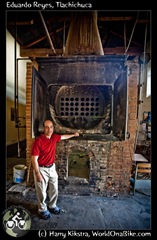 I had gotten in contact with the best-known local organisation, led by the Reyes family. For many generations, this family has been an important factor for the town of Tlachichuca as well as for the exploration of the Pico.
I had gotten in contact with the best-known local organisation, led by the Reyes family. For many generations, this family has been an important factor for the town of Tlachichuca as well as for the exploration of the Pico.
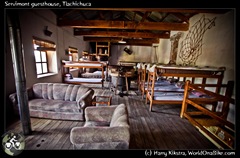 I met up with Gerardo Reyes, who showed me around their family mansion, a former soap factory, where we spent the night.
I met up with Gerardo Reyes, who showed me around their family mansion, a former soap factory, where we spent the night.
Though he could not arrange a guide at short notice, we arranged that his driver would take us to and from the base camp hut the next day, so I could climb it by myself.
15th June: Tlachichuca – Base camp Pico de Orizaba, 2400m – 4200m (8000-14,000ft)
Gerardo was kind enough to borrow me some climbing gear as I had almost nothing with me besides our camping gear. Ivana had decided that she would not climb the mountain, but she would accompany me in to the base camp for support.
The huge 4wheel drive took us through small mountain towns, through pine forests over a very bumpy sandy road. I had read that sometime people attempt to drive up here in regular cars, but it seemed completely impossible to me. It would make a nice downhill, but only on full suspension bikes; Kowalski would get a heart attack here and maybe even break something.
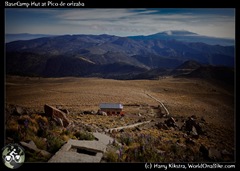 The main climbing season is in winter when the hut is often completely packed with people camping outside as well. Now the hut was totally empty, leaving us to choose from the few dozen wooden spaces. We felt the altitude difference and I only went for short hike up the remains of the old defunct concrete aquaduct before heading down to the cold hut, removing several Coca Cola cans from the trail on the way down.
The main climbing season is in winter when the hut is often completely packed with people camping outside as well. Now the hut was totally empty, leaving us to choose from the few dozen wooden spaces. We felt the altitude difference and I only went for short hike up the remains of the old defunct concrete aquaduct before heading down to the cold hut, removing several Coca Cola cans from the trail on the way down.
The driver had shown us a small source of fresh and clear water and we spent the rest of the afternoon reading, cooking, eating and drinking tea and soups to hydrate well in order to prevent altitude disease.
16th June: Base camp to the glacier: 4200-5100m (14,000-17,000ft)
I woke up early for a hike up the mountain. The route description I had read and heard were very broad and vague and also outdated as the glacier had retreated considerably in recent years. For the climb to the summit I would have to find my route in the dark in order to come safely down during the day time, so today I was going to find my way up to the glacier.
The start was very easy as the concrete remains and the well-beaten path were clear. But then the path split several times forcing me to check several variations before deciding on the best one.
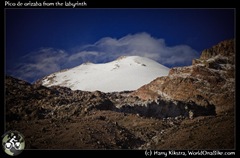 The last section before the glacier had been covered by ice not so many years ago, but now it was a rocky mess. There were little ‘stone men’ and other route pointers everywhere, rendering all of them useless. This section is now called The Labyrinth, as it is easy to loose the way; that is, if you know it in the first place 🙂
The last section before the glacier had been covered by ice not so many years ago, but now it was a rocky mess. There were little ‘stone men’ and other route pointers everywhere, rendering all of them useless. This section is now called The Labyrinth, as it is easy to loose the way; that is, if you know it in the first place 🙂
Still it was not to steep and with some scrambling I found a quite straightforward way up to the plateau, where some soft sandy ridged led me to the glacier. It looked sad, more like a thin crusty snowfield than a mighty glacier. I guess that in only a matter of decades, maybe even years, it will be reduced to some scattered snow patches before disappearing forever.
It felt good to be in the mountains again. Even on a relatively easy mountain like the Pico, the fresh air, the views, the excitement, the thin air and the exercise all made me feel very alive as always. It was nice to be the only one on the mountain, the solitude makes the experience stronger.
The strong cold wind and the upcoming clouds reminded me of the force of the mountains and I hid behind some rocks to eat some sandwiches and drink more, staying as long as possible without cooling down too much, to maximise the acclimatisation effects of this reconnaissance trip. Even with searching it had taken less than 3 hours to the glacier, and from here the route would be straightforward to the summit, so I felt good about trying for the next day.
The way down through the cloudy Labyrinth turned out to be difficult to find than the way up. Several times I found myself on top of a steep drop, before the not so obvious, but much easier route down opened itself up for me.
Later that afternoon I heard a car coming and soon we were surprised by 3 new visitors: Anabel, a young climber from Spain, her boyfriend Victor and a local guide named Guadalupe.Victor was not climbing, but Anabel and her guide were going to try for the summit this night as well, so we decided to climb up together for safety and for the company.
17 June 2009: climbing in the dark
We woke up at 01.00, had our breakfast, packed everything and headed into the dark night before 2Am. It was cold outside, but at least the rainy clouds from the day before had disappeared, making way for thousands of stars. We chatted about our climbs and the mountains and time passed quickly. We went slower than I had done the day before, but as Guadalupe knew his way without any hesitation, we made it to the start of the glacier in about the same time as the day before.
 Anabel was feeling the altitude and was slowing down. After we had put on our crampons, Guadalupe tied her to his rope and went first. I followed shortly after, but did not go on the rope. I liked the feeling of climbing alone and it gave me time and space to stop for pictures without bothering anybody.
Anabel was feeling the altitude and was slowing down. After we had put on our crampons, Guadalupe tied her to his rope and went first. I followed shortly after, but did not go on the rope. I liked the feeling of climbing alone and it gave me time and space to stop for pictures without bothering anybody.
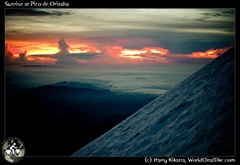 The climb up the glacier was straightforward as expected. We slowly switch-backed our way up, while the sky in the east slowly turned purple, then orange as the sun rose behind the storm clouds of the Gulf coast, showing the mountains, clouds, cities and fields around us.
The climb up the glacier was straightforward as expected. We slowly switch-backed our way up, while the sky in the east slowly turned purple, then orange as the sun rose behind the storm clouds of the Gulf coast, showing the mountains, clouds, cities and fields around us.
 Anabel was almost grinding to a halt and was not sure if she was going to make it, but with encouragement from two sides, she continued slowly but steadily.
Anabel was almost grinding to a halt and was not sure if she was going to make it, but with encouragement from two sides, she continued slowly but steadily.
The shadow of Pico de Orizaba projecting on the fields appeared on our right when the sun made it above the clouds and with the sun came a new energy, pushing us up the glacier to the rocks of the crater rim.
The summit of Mexico!
 It was almost 07.20 when we walked along the Crater edge to the mangled iron that once was a summit cross.
It was almost 07.20 when we walked along the Crater edge to the mangled iron that once was a summit cross.
Even with the many stops on the glacier, it had taken less than 5.5 hours, which was very good.
 We congratulated each other with being the highest people between Alaska & the Andes.
We congratulated each other with being the highest people between Alaska & the Andes.
The weather was great and we took our time to eat, drink and take plenty of pictures, before heading down the glacier, here is a selection ( click to enlarge, more photos are in the photo section here).
Running down
 It was a quick walk down, as the snow already was softening and with the thicker air, Anabel’s energy returned. We sped down the rocks and were greeted outside the hut by Ivana & Victor, who were barely awake. They wondered if we had made it as it was only 10 ’o clock!
It was a quick walk down, as the snow already was softening and with the thicker air, Anabel’s energy returned. We sped down the rocks and were greeted outside the hut by Ivana & Victor, who were barely awake. They wondered if we had made it as it was only 10 ’o clock!
The others went down quickly, but we had to await our ride back, that was scheduled for the afternoon. After another bumpy ride down we arrived back at the Reyes mansion, where a warm shower was our reward.
18th June: to the lowlands!
I would not have liked to miss the great days in the mountains, but now we really had to hurry to get to Cancun in time, we had to get moving! We need to get a lot of rides or take a bus, but still there was one more section to cycle that we did not want to miss: downhill 🙂
Kowalski! Status report!
Knees are doing quite ok, and with the upcoming break in Cancun I am positive that we are able to continue cycling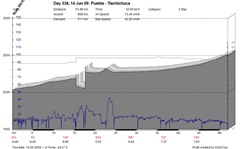 .
.
Here are some figures you might enjoy:
- Distance cycled: 10,241 km (6363 Miles)
- Days on the road since Prudhoe Bay, Alaska: 341
- Days actually cycling (riding days: more than 25km/15miles): 146
- Time really spent cycling (not including stops, waits, lunches etc): 695 hours for Harry, probably 750 or so for Ivana, as she cycles a bit slower.
- Average real riding time on the riding days: 4 hours and 46 minutes per day
- Average speed for Harry since Alaska: 15km/hr or 9.3mi/hr
- Flat tires: we did not really keep count, but I think about 6 for Ivana and about 5 for Harry
Day 336-338, 12-14 June. An impression of beautiful Puebla.
September 18, 2009 by Harry,
Filed under Trip reports, North America, Mexico, Central Mexico
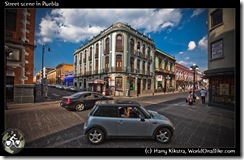 It was less than 10km from Cholula to Puebla and the cities are basically connected. With 1.5 million people the city is huge (3rd largest of the country), but the historic centre has remained largely intact and is very attractive.
It was less than 10km from Cholula to Puebla and the cities are basically connected. With 1.5 million people the city is huge (3rd largest of the country), but the historic centre has remained largely intact and is very attractive.
We had been invited by CouchSurfing host Hiram and his family, who own and run a very popular Mexican restaurant together. Still he had time to do a quick city tour with us and gave us a lot of tips of where to go while he was at work.
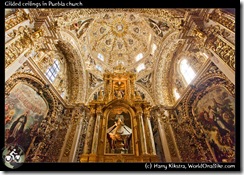 One impressive place he pointed out is the fully gilded Rosary Chapel of the Templo de Santo Domingo, which is so shiny, you almost need sunglasses.
One impressive place he pointed out is the fully gilded Rosary Chapel of the Templo de Santo Domingo, which is so shiny, you almost need sunglasses.
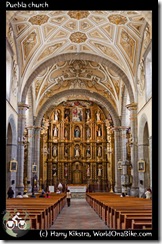 The zocalo or main square is the courtyard of the huge Cathedral, with Mexico’s highest towers. Rich people see it regularly as it appears on the 500 pesos note (about USD$ 40, more value than most Mexicans see in one bank note).
The zocalo or main square is the courtyard of the huge Cathedral, with Mexico’s highest towers. Rich people see it regularly as it appears on the 500 pesos note (about USD$ 40, more value than most Mexicans see in one bank note).
But maybe the best part of Puebla is just strolling around the centre, through colourful streets lined with colonial houses, with patios and balconies.
Tourists and locals are enjoying themselves everywhere on the terraces and restaurants and in the many shops lining the streets.
Fiesta
Puebla has always been a Catholic stronghold and this has resulted in many religious celebrations, many of which have the benefit that a lively street market will take place, just a few blocks away from the zocalo.
We enjoyed the different foods for sale, the fair rides for kids, the artesanias, the music and the general positive atmosphere. Had I said before that everybody should visit Mexico? Just in case I’ll do it now: do not let biased political media scare you away from a wealth of culture, nature, gastronomy and friendliness, visit Mexico.
There, I said it.
Now, I invite you to take a look at some impressions of the market and the city. (Click for a larger version, these and more photos of Puebla are also in the photo section here).
Mexican treats in El Balcon
We arrived back late at ‘El Balcon’, the restaurant of Hiram’s family. Late at night it was still completely packed and several people were waiting outside. No, it is not (yet) in the Lonely Planet as it is (just) 7 blocks away from the centre, but the locals clearly know where to go. Even when they changed locations a while ago, the clients followed for the clear and honest food.
 Hiram also took us up the Cerro de Guadeloupe, which is not only the place where the French were defeated on 5th may 1862 (hence all the street names all over Mexico named 5 de Mayo), but on clear days you can also see the silhouette of Izta, the mountain known as the sleeping woman.
Hiram also took us up the Cerro de Guadeloupe, which is not only the place where the French were defeated on 5th may 1862 (hence all the street names all over Mexico named 5 de Mayo), but on clear days you can also see the silhouette of Izta, the mountain known as the sleeping woman.
He introduced us to his friend and fellow CouchSurfer Leandro. We did not have time to visit his place, but had some good discussions about life and saw some more hidden gems of the city together.
Hiram’s parents were worried about our trip and hugged us close and shed some tears when praying for our safe journey. We are not religious ourselves, but the care and love of people that were strangers 3 days before keeps on surprising and warming us. So maybe the prayers do help as we will take care, so we can meet more great people like them and maybe one day return the favour.
Back on the road again..
Fortunately we found the way around the steep hill when we left Puebla, sooner than we would have liked. If we’d hurry, we would maybe have time for one more activity before we really had to get to Cancun.
Our mums were already getting very worried that there would be nobody to pick them up when arriving in 2 weeks. But before we would leave the Mexican highlands to get back down to sea-level, there was one place far from it that I wanted to visit…
More soon 🙂
Day 332-335: 8-11 June: Mexico City-Cholula, canals, interviews, city and volcanoes
September 16, 2009 by Harry,
Filed under Trip reports, North America, Mexico, Central Mexico
Cycling through the outskirts of Metepec was still ok, but when we reached the main road from Toluca to Mexico, we had to use all senses we had to stay alive. We stopped at a gas station 20km out of town, as it was no use to try to cycle into the city any farther. There was a big climb ahead, the toll roads was completely full with cars and the free road even fuller, but then with trucks as well, neither having a decent shoulder for cycling.
We got a ride from a nice guy who worked for a TV station in the city. He took us over the high pass and down to one of the biggest cities in the world: depending on your definition, around 20 million people live in the valley!
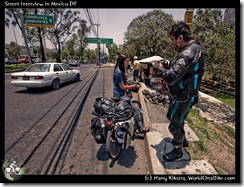 He dropped us off at his office, conveniently situated near the ‘periferico’, the huge highway, circling all around the centre of Mexico City. We were on our way to Ulises, yet another CouchSurfing host. According to the map, it was only about 10km to his house.
He dropped us off at his office, conveniently situated near the ‘periferico’, the huge highway, circling all around the centre of Mexico City. We were on our way to Ulises, yet another CouchSurfing host. According to the map, it was only about 10km to his house.
The periferico was the logical and fastest way, but filled with fast traffic as well, which we were not. Luckily, there was another road right beside it, with traffic lights and less hurry. As we still had some leftover free miles, we made it to Ulises’ area quickly, only interrupted by a taxi strike that had blocked some roads. Just after passing the blocked area, a TV reporter on a motorcycle did a quick interview with us, right on the street, not sure if it made it to the evening news.
We made it safely to Ulises’ house, but could have had some serious trouble as several metal drain covers were missing on the road, exposing holes without visible bottom, and 60cm/2ft across.
Ulises and his family welcomed us with open arms and treated us to some more Mexican dishes. Forget about Taco Bell, if you love real food (duh), you need to visit Mexico sometimes, as every region has its own different tasty specialties.
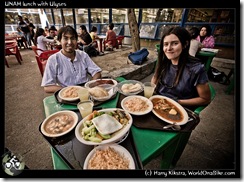 Ulises is studying engineering, specializing in the movements of the earth underneath the large buildings in the historic centre. he could as well been a professional guide if he wanted, as he shared his encyclopaedic knowledge about the culture and history of the City.
Ulises is studying engineering, specializing in the movements of the earth underneath the large buildings in the historic centre. he could as well been a professional guide if he wanted, as he shared his encyclopaedic knowledge about the culture and history of the City.
It was a shame that we had to rush, as there are many things to see in the city, that actually consists of many smaller towns and neighbourhoods, all absorbed into the giant metropolis, but with their own character and attractions.
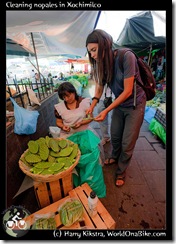 We ate a great and cheap lunch at the huge UNAM University complex, actually a city in itself, where the future of Mexico is being shaped. In the afternoon we visited the market and historic centre of Xochimilco, in the South part of the city.
We ate a great and cheap lunch at the huge UNAM University complex, actually a city in itself, where the future of Mexico is being shaped. In the afternoon we visited the market and historic centre of Xochimilco, in the South part of the city.
Ivana took a quick lesson how to prepare the nopales, the flat cactus leaves that is a popular vegetable. We relaxed and took a Gondola tour through the ancient canals that are still open and of course enjoyed more paletas and drank a ‘pulque, the ancient fermented drink that is still popular.
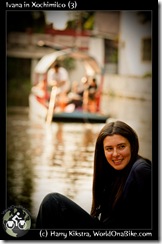 For about USD $10 you get a private boat for an hour, complete with a gondolier slowly pushing the boat through canals lined with nice houses & lush green trees.
For about USD $10 you get a private boat for an hour, complete with a gondolier slowly pushing the boat through canals lined with nice houses & lush green trees.
It was low season and not busy, but besides a few other boats with tourists, there are usually also boats selling food, drinks and souvenirs, and even some Mariachi boats with a complete orchestra that will play a song for a small charge. There are party boats where the youth come to drink and dance and complete families have reunions and a good and relaxed time, while floating slowly on the ancient waters.
You would have no idea that you are in one of the largest cities in the world, that was completely shut down a few weeks before because of fear for the ‘swineflu’.
Life in the city
There are enough sights, museums and monuments to keep you busy for weeks, if not months in Mexico City. The centre is well-known, the main square (where photographer Spencer Tunick once captured a record 18,000 nude people, a shock to the Catholic country) with the nearby ruins, government buildings, huge flag and the grand cathedral. As we had little time to do the city justice, we opted to see some of the lesser known pretty places where people actually live and work. There are parks, a small Chinatown, many big office buildings and all kinds of museums and interesting buildings.
We walked and rode the bus and the infamous subway between all of them and noticed that:
- nobody was wearing the mouth covers we saw in the news, just some people serving in restaurants &
- we did not get robbed, pick pocketed, kidnapped or molested once, how weird is that!
In the evening we visited some older towns that had been swallowed by the city. Friendly Tlalpan was as quiet as any small country town and beautiful Coyoacan should be one of the Pueblos Magicos, as pretty and relaxed as it is. Nope, again, no robberies and the air was clean.
10th June 2009: Interview and into thin air!
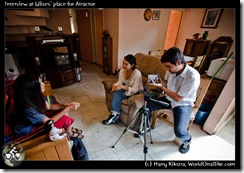 The next morning we were interviewed by some nice guys, for a new online magazine, called Atractor; the interview can be seen online here.
The next morning we were interviewed by some nice guys, for a new online magazine, called Atractor; the interview can be seen online here.
We had told Ulises that we wanted to see the Paso de Cortez, the famous mountain pass between the mountains Izta & Popo, where Cortez made his way to the valley. Ulises advised against cycling out of the city and as he loved the place, he offered to bring us there with his small car. 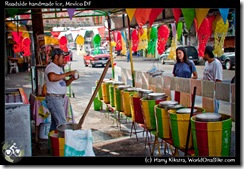
After lunch (Chicken with green mole!) we loaded our bikes on the bike rack, just fit all the bags inside and headed out the city. We stopped at one of the many handmade ice-cream stalls and continued up and over several nice little towns, situated on grassy fields.
The actual road up to the pass was steep, but paved and even though it rained, we slowly rose above most of the clouds, feeling happy we were not cycling/pushing our bikes through the rainy forest. The pass and a visitor centre are at about 3500m/12,000ft altitude, but the huts and camping spaces are higher.
We continued on a slippery and rocky unpaved road and made it all the way up to a large hut. It seemed deserted, but after knocking repeatedly, the guardian Miguel opened up and let us in. We had brought our tent, but for a few pesos, we could stay in the cozy hut, so we opted for that instead, enjoying the sunset behind Popocatepetl (‘Popo’), with 5452m/18,000ft the 2nd highest mountain of Mexico.
Miguel enjoys living between the mountains and had taken thousands of pictures of the mountains and the wildlife on it and showed us many great ones on his laptop, while we ate some snacks together for dinner.
Popo, the warrior and Izta, the sleeping woman
Popo can no longer be climbed, as it is still very active and the constant fumes are lethal. Popocatepetl means ‘smoking mountain’ and only 4 years ago a large eruption shot 5km into the air keeping 30 million people that will be impacted by a larger blast awake…
Iztacihuatl (‘Izta’) on the North side of the pass and with 5220m only a few hundred meters lower, is dormant and still climbable, though the glaciers are shrinking. We did not have any glacier gear so just stuck to enjoying the magnificent mountains from the pass.
There are a lot of variations on the legend of Popo & Izta. Basically warrior Popo was in love with Izta, but was told by her parents that she had died when he was in battle. Izta was told the same about Popo and died of grief. Popo returned to find his loved one dead and laid her on the land, while resting sadly besides her.
This is why Iztacihuatl is known as ‘The Sleeping Lady’, as on clear days after snow, the mountain scarily resembles a woman lying down on her back, with the classic Volcanoe-shaped Popo at her feet. The several summits are known as the Knees, the Head and the breast.
The next morning we woke up early to see the sunrise with Miguel. It was cloudy, but far away we could see the perfect shape of the summit of Pico de Orizaba, the highest mountain of Mexico (and 3rd of North America, after Denali & Mount Logan). As to salute the sun, Popo shot a small eruption into the multicoloured sky.
We love seeing the cities and how the people live in faraway countries, but natural shows like these always impress more than anything else…
.
To protect the bike as well as the car, we mountain-biked down to the pass while Ulises drove the car with the luggage down. We loaded our bikes up at the pass and said our goodbyes and thank-you’s to Ulises who had helped us out so much.
The east side of the Paso de Cortez is unpaved but the first few kilometres the smooth volcanic road was gentle enough. However, once we entered the forest again the road became horrible, slowing us down to protect the bikes, luggage and our spines. Big rocks were on the road and it was impossible to go fast, even though it was so steep we had to brake constantly. This lasted an hour or so, and if you ever are thinking about it: do NOT try to cycle up this side unless you are a professional mountainbiker without luggage…
We had lost a lot of altitude, but luckily there were a few free miles left when we hit the pavement and we zoomed through the fields towards Cholula. Usually we aim for the church if we want a place to have lunch as usually the Catholics have claimed the best and culturally richest parts of all Latin cities and normally the places are very beautiful.
In Cholula we had to search a bit for the pretty zocalo as Conquistador Cortes had almost 40 churches built after taking the city, but we ended up in the park, eating and relaxing from the downhill, only disturbed by a series of processions that came with terrible music and loud bomba’s, very noisy explosives shot into the air.
We had aimed to get to Puebla but stayed in Cholula that night with another CouchSurfer that offered a last-minute couch. We almost passed the giant Piramida Tepanapa, unnoticed as it is so big and covered with grass, that it looks like a huge hill. As often, there is a Catholic Church built on top, but they also might not have known that there was the largest pyramid on earth underneath.
Cholula is nowadays connected with Puebla, but in order to see more of the latter, we decided to move to Puebla, to see the often acclaimed city with our own eyes… We still had to rush, but my feet had started itching when I had seen the highest mountain in Mexico from afar… Would there maybe be time to… ? Tune back in to WorldOnaBike next time 🙂
Kowalski! Status report!
- Our bikes survived the downhill, though Ivana got a flat tire on the sharp rocks there.
- Knees and back are ok, but we are getting a bit nervous as we have to be in Cancun within 2 weeks…
- Total km cycled (excluding rides): 10,370 (about 6500 miles)
- More pictures of Xochimilco and Popocatepetl can be found on the picture page: http://harry.biketravellers.com/photos . as always, larger versions of the images appear automagically when clicking on the small versions (when reading this on http://WorldOnaBike.com). Try it!
Day 325-331, 1-7 June 2009: highland magic in Morelia
September 14, 2009 by Harry,
Filed under Trip reports, Tips & Tricks, North America, Mexico, Central Mexico
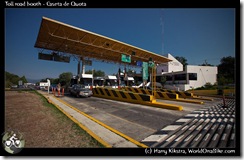 We were dropped off in the morning at our favourite pick-up spot: the tollbooth of the quota. For once we were not the only persons there without a car, as a demonstration of angry teachers was about to commence.
We were dropped off in the morning at our favourite pick-up spot: the tollbooth of the quota. For once we were not the only persons there without a car, as a demonstration of angry teachers was about to commence.
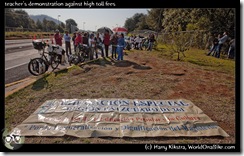 The toll roads in Mexico are very expensive, most truck drivers and definitely the underpaid teachers cannot afford to use them, so they were going to occupy the booths and let everybody go free as a protest.
The toll roads in Mexico are very expensive, most truck drivers and definitely the underpaid teachers cannot afford to use them, so they were going to occupy the booths and let everybody go free as a protest.
Unfortunately the guy that Ivana asked to give us a ride to Morelia had already paid. When he stopped to load our bikes in the back of the truck, he noticed the few dozen of people waiting and carefully asked ‘How many people need a ride again?’ 🙂
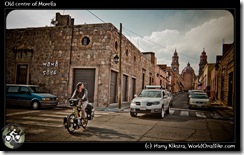 We had not expected to get to Morelia so soon, but it was nice to have some time to cycle through the old city. Morelia is one of the reasons people should visit Mexico: it has a wonderful historic centre, full of culture and with loads of buildings that are older than anything in the US. The university city is full of young people and there are plenty nice places to eat, drink or party if needed.
We had not expected to get to Morelia so soon, but it was nice to have some time to cycle through the old city. Morelia is one of the reasons people should visit Mexico: it has a wonderful historic centre, full of culture and with loads of buildings that are older than anything in the US. The university city is full of young people and there are plenty nice places to eat, drink or party if needed.
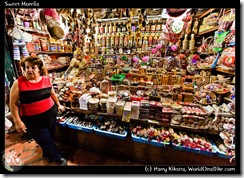 We had been invited by our new CouchSurfing friend Monica to stay with her family, we were already the 3rd cycling couple they had hosted. Monica and her family took great care of us and we stayed much longer than planned. We still had a deadline to meet, but the generosity of Monica, her mother Yolanda, father Juan and brother Juan Pablo kept us relaxed.
We had been invited by our new CouchSurfing friend Monica to stay with her family, we were already the 3rd cycling couple they had hosted. Monica and her family took great care of us and we stayed much longer than planned. We still had a deadline to meet, but the generosity of Monica, her mother Yolanda, father Juan and brother Juan Pablo kept us relaxed.
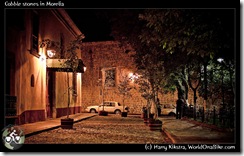 Yolanda is not just a great conversationalist with a lot of knowledge about history, culture and politics, but also a great cook. She surprised us every day with new local dishes, made with fresh and tasty natural ingredients only.
Yolanda is not just a great conversationalist with a lot of knowledge about history, culture and politics, but also a great cook. She surprised us every day with new local dishes, made with fresh and tasty natural ingredients only.
A welcome relief from the fast-food stores that are popping up everywhere in Mexico and from the pre-processed chemical packages that are sold as ‘food’ in the many small supermarkets. She even gives free classes about nutrition in schools and every meal was a feast.
We got to rest and recover from the hot Mexican coast My cut healed well and left only a small scar in the shape of a ‘7’, which is actually pretty cool 🙂
Patzcuaro, the magic town
When we mentioned that we would have to leave soon, they said that we could not go without seeing Patzcuaro, and they took us to this historic town between Uruapan & Morelia: one of the few dozen ‘Pueblos Magicos’, a list of less than 30 ‘magical cities’ of Mexico. Places that give you that special feeling…
We enjoyed the lake, ate real quesadillas on the market, had handmade ice-cream at the main square and admired the historic buildings and culture. Many local artists are producing and selling their artesanias on the streets and in little shops around town.

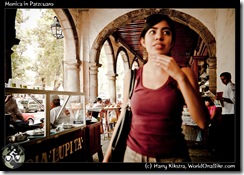
.
As in more historic places in Mexico it is illegal to have big loud advertising in the centre. All shops have the same colours and use the same fonts to advertise their name outside, which secures a wonderful low-key relaxed feeling.
So even though Burger King might have infiltrated in the main square commercial zone, you won’t know it is there until you are almost inside. But why eat there anyway, when there are delicious huge quesedillas for USD$0,50 and tons of unknown but cheap and tasty fruits instead?
Goodbye to Morelia
 Monica had already taken us a few times to some nice dinners and walks in the historic centre of Morelia and even organised a CouchSurfing meeting for us.
Monica had already taken us a few times to some nice dinners and walks in the historic centre of Morelia and even organised a CouchSurfing meeting for us. 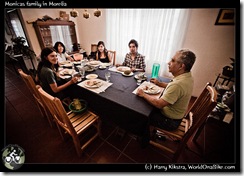
It was hard to say goodbye to this generous family, as many times before we felt we had taken more than we could give in return. We felt privileged to be a part of the family for while and to see yet another side of the diverse Mexican culture.
Back on the road again, heading for DF. Paletas & hills.
If you are in another country and you are heading for ‘Mexico’, you are heading for the country. Once you are there and you are still heading for ‘Mexico’, everybody knows you are going to the capital with the same name. I must admit that I knew nothing much more about Mexico City than that it is one of the largest cities in the world, with accompanying pollution and crimes. Recently, it was known as the ‘Swine flu capital’, though all news sources in Mexico report that the flu originated in the US, so who should you believe?
Anyway, as we always like to see things for ourselves rather than trusting media copycats, we decided that we should at least try to visit the Capital.
Monica & Yolanda guided us out of Morelia and pointed us to the new toll road. Unfortunately the arrogant boss of the accompanying complex would not let us cycle, nor leave us waiting for a ride. All the guards said that once the chief would be away, we would be fine. In the end we managed to ask for a ride and get our bikes loaded on a truck while the driver was paying his toll.
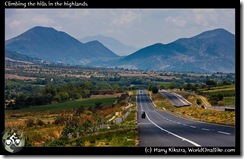 The car dropped us off at Zinepecuaro, where we enjoyed the first of many ‘paletas’, locally made ice-lollies made with big chunks of pure fruit, like Guanabana, coconut, pineapple or my favourite, mango with chile: cold, sweet and spicy!
The car dropped us off at Zinepecuaro, where we enjoyed the first of many ‘paletas’, locally made ice-lollies made with big chunks of pure fruit, like Guanabana, coconut, pineapple or my favourite, mango with chile: cold, sweet and spicy!
A steep road headed up to the main toll road between Guadelajara & Mexico city. The toll booth attendant did not even see us when we sneaked past. We could try to catch a ride here, but decided that we try some highland cycling instead. We regretted that soon as the next 15km was constant and very steep uphill. 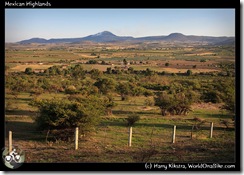
Even though we were at about 2400m/8000ft, it was hot and we had run out of water on the long climb. At the summit we got a bag full of sweet strawberries from a street vendor, which we enjoyed between the pine forests of the highlands.
After an initial downhill there was another smaller hill to climb but then we could enjoy our well-earned ‘free miles’, all the way down to the city of Maravatio. We cycled into town and saw the sign of the Cruz Roja, the red Cross.
If you are ever cycling in a town and have no idea where to stay safely and cheaply, here are some recommended choices, in no particular order, but generally valid all over the world:
- The fire station (Bomberos in Latin America). They usually have nothing much to do and enjoy the company, usually have some extra rooms or at least a safe place to camp
- The Red Cross: same as the Bomberos, + benefit of providing medical help if needed
- The Police: even though sometimes they have a bad name, generally speaking it is a lot safer to stay between police men than between the thieves they are trying to catch 🙂
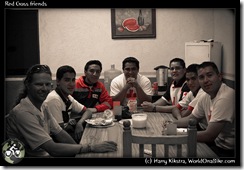 We got some water from the friendly nurses at the Cruz Roja and cooked our spaghetti outside the main entrance. Just after had put up our tent, the team leader cam out and offered us to stay inside instead and use the WiFi as well, which was of course gladly accepted.
We got some water from the friendly nurses at the Cruz Roja and cooked our spaghetti outside the main entrance. Just after had put up our tent, the team leader cam out and offered us to stay inside instead and use the WiFi as well, which was of course gladly accepted.
It was nice to see young (most were between 16 & 20) volunteers, trying to help out in the community, while being educated.
The following day we still had some free miles saved and the kilometres passed quickly through gentle hills and green fields passing over small towns.
It was still a long way to the City and so we stopped at the next tollbooth, where we got a ride fairly quickly. Fortunately we passed the busy madness of Toluca city, and got dropped off right in Metepec, where Monica’s aunt & uncle live.
When we cycled to the charming main square to call them for directions, a group of young cyclists came up and started asking questions about our trip. They were really interested and also used the opportunity to practice their English. They guided us through the small streets, stopping cars to let us pass easily and even called Monica’s family when needed. It was great to have such a young and enthusiastic cycling escort!
We were received with open arms by Laura & Roberto and their son Beto in their house outside of town. To the west we could see the impressive massif of Volcan de Toluca, to the east were the high mountains separating us from one of the largest urban zones in the world, currently feared by the world because of some strange virus… Mexico City, here we come!


